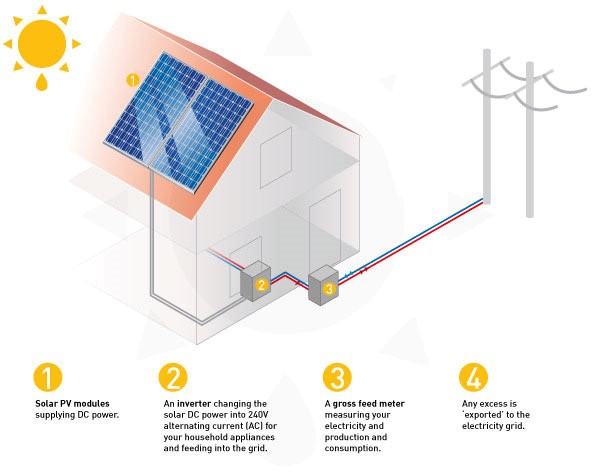How does solar work? What is a grid-tied solar electric system?
Solar panels are generally roof mounted (although they can also be ground mounted) and placed at the correct angle to take full advantage of the sun. As the sunlight hits the panels, it creates DC electricity, which is then converted by an inverter into the 240V AC electricity which we use for power.
Solar panels are a static generator meaning they have no moving parts. Modern solar panels are quite efficient even when sunlight strikes them at oblique angles. It is ideal to have a South facing roof to mount the solar modules although 90 degrees off South is acceptable.
Since the sun only shines during some hours of the day, a battery system or other electric storage system is necessary so that electricity is available at all times, including at night or on cloudy days. In a grid-tied system, the electric utility system acts as a giant battery. When your solar panels are generating more energy than you are currently using the excess energy is sent to the electric grid. Likewise, at night when you are using more energy than your solar panels are generating, the electric grid supplies the additional electricity needed. In a grid-tied system the electric meter keeps track of electricity flowing in both directions.
Proven Technology
When it comes to switching to solar power, the time is truly now. The rule of thumb when utilizing any new technology is “wait until it’s tried and tested”. For solar panels, that wait is over. Lakeshore Solar uses crystalline silicon technology, the most reliable, proven solar technology available. Panels today last more than 30 years at high efficiency levels.
90%, of solar panels sold today are crystalline silicon panels. To make these panels, raw silicon (sand) is melted at very high temperatures and impurities in the silicon are removed. In their place, new specific impurities (called dopants) that allow the movement of electrons within the silicon are introduced. The special semiconductor properties of silicon, combined with these specific impurities, allow electricity to be generated when light hits the silicon. The melted silicon is cooled and forms crystals as it solidifies into an ingot of pure silicon. The ingot is then sliced into thin wafers that will sit out in the sun and generate electricity. The thin wafers are soldered together to a metal backing, covered with durable glass that resists hail strikes, and mounted to the roof or other framework. Solar panels are incredibly resilient and durable.
Smarter Systems
While there have been few advances in residential solar panel technology in recent years, there has been one major advance in inverter technology — panel optimizers. Lakeshore Solar uses Enphase microinverter optimizers.
Traditionally, solar panels are connected together in a series of circuits fed into a single, central inverter device. This means that one inverter controls tens of solar panels as if they are one unit operating at the same power level. This approach reduces the overall system efficiency and limits the available information about individual panel performance. One panel that might be partially shaded could reduce the output of all panels on that string.
Replacing the central inverters with optimizers that attach to each solar panel allows each panel to operate independently, leading to significant improvements in energy production and adding a new layer of intelligence throughout your solar system. With panel-level optimization, you also get greater design flexibility in the placement of your panels and an easily expandable system.
To learn more about your solar opportunity, let Lakeshore Solar provide you with a free, no obligation assessment today.
Get a free assessmentSolar Installation – The Details Matter
Solar Electricity Production Estimates – Lakeshore Solar will provide you with a detailed financial profile for you solar investment. Expected annual production, cash flows, out of pocket costs, incentive breakdown, net present value (NPV), internal rate of return (IRR), simple payback period, production ratio, and levelized cost of energy (LCOE) are among metrics to compare when evaluating systems.
Installation date – Most property owners want their systems completed and interconnected yesterday. Lakeshore Solar will provide you with a documented timeline and installation checklist.
Workmanship Warranties – These warranties often ensure that there is no additional out-of-pocket risk in the first few years of system ownership. Lakeshore provides a 10 year service warranty and 25 year equipment warranty.
Shade Mitigation –Intermittent shade due to trees or other obstructions will impact the amount of electricity your system produces (less sun equals less energy!). Lakeshore Solar can address this using micro-inverters to help keep the system producing at a high efficiency despite some shading.
Technology Choices – All panels, inverters, monitoring systems and racking / mounting equipment are not created equal. Lakeshore Solar will provide you with the best design and equipment for optimum cost, system production and reliability. This will insure that your system generates solid financial returns.
Installation Quality – Lakeshore Solar prides itself on the quality of its installer’s workmanship. We pay attention to the aesthetics and appearance, not just the production of energy.
Monitoring – Lakeshore Solar includes a monitoring system with a revenue grade meter. Lakeshore Solar provides a monitoring system that will show the production and status of your solar power installation as well as calculating equivalent environmental benefits. See the Smart Solar page for more information.
Roofing – A building owner should know that even a detached, ballasted solar system sitting on a roof, can easily invalidate the original roofing warranty. As part of our installation, Lakeshore Solar can correct any roofing deficiencies, and will insure the existing roof warranty is amended to reflect the addition of the solar installation. Some clients may also be at a point where their roof needs to be replaced; solar can help offset this expense and be installed on new roof at same time to optimize overall installation costs.

